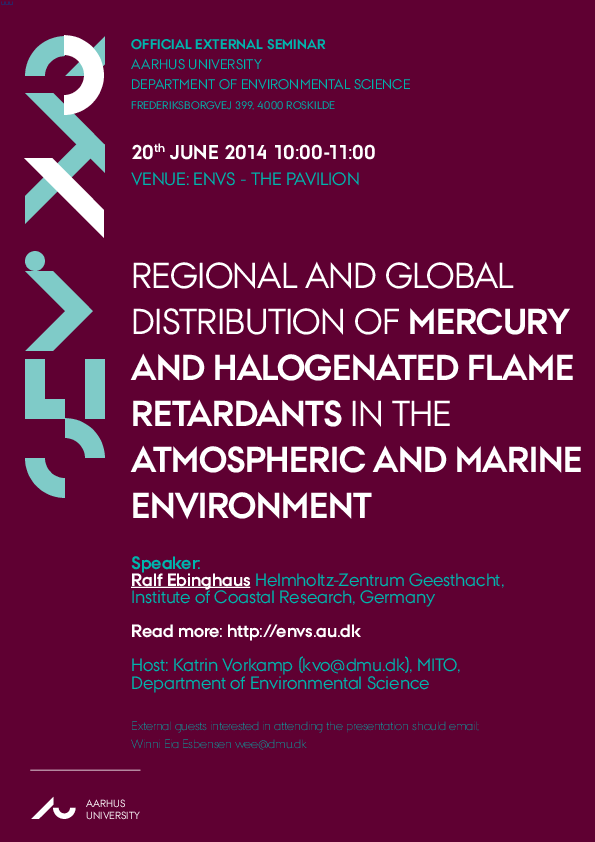Official ENVS seminar with Ralf Ebinghaus, Helmholtz-Zentrum Geesthacht, Institute of Coastal Research, Germany
Regional and global distribution of mercury and halogenated flame retardants in the atmospheric and marine environment
Info about event
Time
Location
THE PAVILION
Organizer

You are hereby invited to an official ENVS seminar Friday 20 June, 10:00-11:00 in the Pavilion.
See poster here and read abstract below.
Regional and global distribution of mercury and halogenated flame retardants in the atmospheric an marine environment
Although completely different in nature and origin, mercury (Hg) and Persistent Organic Pollutants (POPs) have common properties such as semi-volatility, fairly low chemical reactivity, high potential for bioaccumulation and long-range atmospheric transport at least on hemispheric scales. Consequently both are subject to international environmental treaties: the Stockholm Convention on POPs, signed in 2001 and the Minamata Convention on Mercury which was adopted and opened for signature in October 2013.
In the first part, this presentation will give an overview about major sources and regional distribution of atmospheric mercury in temperate regions summarizing our research carried out in the past 20 years. Special emphasis will be related to trends in the Northern hemispheric atmospheric pool. Recent findings on fast tropospheric oxidation processes of atmospheric mercury during Arctic and Antarctic springtime will be presented and discussed. This phenomenon occurs simultaneously with tropospheric ozone depletion and BrO formation, as shown from satellite data. It is supposed that this process can lead to significantly enhanced deposition fluxes of atmospheric mercury into polar ecosystems. Finally, results from the international CARIBIC project (“Civil Aircraft for the Regular Investigation of the Atmosphere Based on an Instrumented Container”) will be presented: Beside ca. 50 other atmospheric constituents, mercury is routinely measured since the beginning of 2005 onboard a long-range passenger aircraft Airbus 340-600 of Lufthansa German Airlines using the new CARIBIC container.
The second part of the presentation will focus on halogenated flame retardants (HFRs), mainly brominated (BFRs), that have been applied to reduce the inflammability of various industrial and consumer products such as textiles and electronics for several decades. Among these, three technical mixtures of polybrominated diphenyl ethers (PBDEs) – PentaBDE, OctaBDE and DecaBDE – were the most used BFRs in the 1990ies and early 2000s. They are known to be harmful for the environment caused by their toxicity, persistence (or degradation to lower brominated, more persistent PBDEs), bioaccumulation potential and potential to undergo long–range atmospheric transport (LRAT). They have been detected worldwide in various matrices. Since the early 2000s, several HFRs have been globally regulated and were replaced by non-regulated flame retardants.
There is growing industrial, scientific, political as well as public interest on these non–regulated non–PBDE HFRs. Nevertheless, there are only a few data on their occurence, especially in non–source regions such as the marine environment, and their transport behaviour. Results on the occurence and transport of PBDEs, several non–PBDE BFRs and Dechlorane compounds in the marine environment from the highly industrialized region of East Asia to the remote region of the Arctic will be presented.
External guests interested in attending the presentation should email; Winni Eia Esbensen wee@dmu.dk
